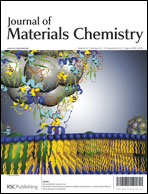Graphene oxide oxidizes stannous ions to synthesize tin sulfide–graphene nanocomposites with small crystal size for high performance lithium ion batteries†
Abstract
This study reports a novel strategy of preparing graphene composites by employing graphene oxide as precursor and oxidizer. It is demonstrated that graphene oxide can oxidize stannous ions to form SnS2 and is simultaneously reduced to graphene, directly resulting in the formation of SnSx–graphene (1 < x < 2) nanocomposites. The particle size of SnSx in the nanocomposites is tailored to be about 5 nm, which is much smaller than that obtained in a previous study. As anodic materials for lithium ion batteries, SnSx–graphene nanocomposites retain a discharge capacity of 860 mA h g−1 after 150 cycles at a charge–discharge rate of 0.2 C, higher than the theoretical capacities of SnS2 (645 mA h g−1) and SnS (782 mA h g−1) based on the traditional mechanism. A possible new mechanism, that Li2S arising from tin sulfide in the first discharge cycle could be reversibly decomposed at a low potential to storage lithium, is proposed based on experimental results to explain the excellent properties of SnSx–graphene nanocomposites.


 Please wait while we load your content...
Please wait while we load your content...